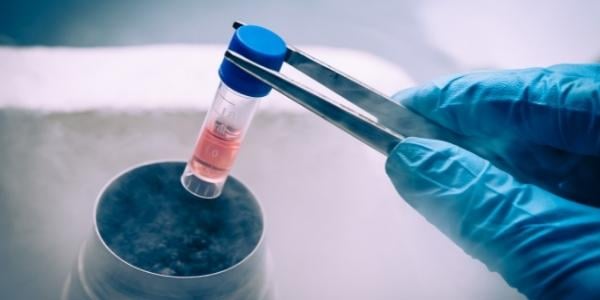 Most of us have heard about stem cells and their vast benefits to humans. In our world, they are used anywhere from innovative beauty treatments to helping with diseases. But did you know that stem cell therapy and technology have also become a new branch in veterinary medicine? The use of stem cells in regenerative medicine is proving to be highly beneficial to our dogs and cats.
Most of us have heard about stem cells and their vast benefits to humans. In our world, they are used anywhere from innovative beauty treatments to helping with diseases. But did you know that stem cell therapy and technology have also become a new branch in veterinary medicine? The use of stem cells in regenerative medicine is proving to be highly beneficial to our dogs and cats.
The purpose of regenerative medicine is to help the body through the support of advanced medical treatments to repair, replace, or regenerate injured, damaged, or diseased tissues. Currently, stem cells are used in regenerative medicine to help treat bone injuries, joint issues such as osteoarthritis, or ligament issues like cranial cruciate ligament (CCL) tears. But as research continues, advances will be made using stem cells to treat a vast number of other illnesses and diseases for our pets.
Where Do Stem Cells Come From?
How Are Stem Cells Stored?
What Does Stem Cell Therapy Include?
Stem Cell Storage Companies
Pet Insurance & Stem Cell Therapy
Is Pet Stem Cell Therapy Experimental?
Benefits & Risks of Stem Cell Treatment
What Are Stem Cells?
What exactly are stem cells? Stem cells are unspecialized cells, meaning they do not have tissue-specific structures to perform specialized functions. Specialized cells, such as red blood cells that carry oxygen, have specific capabilities that allow them to perform specific tasks.
Stem cells can restore themselves via cell division for long periods of time. Typically, after a certain period of time, most cells cannot replicate themselves. But stem cells are self-sustaining (able to maintain themselves). Their period of replication is much longer than that of other cells.
Lastly, these amazing cells can go through the process of differentiation. This means they can take on individual characteristics and mature into cells with specialized form and function, such as osteoblasts to aid in bone formation or pancreatic beta cells to help treat diabetic pets and more. In certain conditions, they can become specific tissues or organs. The benefit to this is that they can help internally by repairing and replacing damaged, diseased, or dead tissues such as muscle, nerves, skin, and more.
Benefits of Stem Cell Therapy:
- They release chemicals to help decrease inflammation
- They stimulate healing to an area by sending out chemicals to the body to bring healing cells
- They can potentially renew or restore damaged tissue
Where Do Stem Cells Come From?
There are three different types of stem cells:
-
Embryonic: Derived from embryos.
-
Hemopoietic: Derived from umbilical cords in babies or bone marrow of adults.
-
Mesenchymal: Harvested from umbilical and placental tissue (newborns), bone marrow, and fat tissues (adults). These last two mesenchymal forms are used in veterinary medicine.
Stem cells are safely harvested from your adult pet’s adipose (fat) tissue or other tissue (bone marrow). A small piece of fat tissue is surgically removed either from the groin or shoulder area while your pet is under anesthesia.
Another method for obtaining stem cells is that they can be taken from and stored for later use from the reproductive organ tissue that is discarded following your pet’s spay or neuter. Dogs of any age can have their stem cells harvested during spay or neuter.

How Are Stem Cells Stored for Future Use?
After the tissue sample has been collected, it is then processed via centrifugation to separate and concentrate the stem cells.
If stem cells are to be used at a later date, they can be preserved and stored. When your dog needs treatment, your veterinarian can order cell culturing so your pet will have a lifetime of stem cells for therapy. Stem cells can also be sent back to your veterinarian for treatment of acute issues while still having some preserved and stored for later treatments.
It is important to know that not all veterinary clinics have stem cell therapy programs (sample collection, processing, and usage). Those that do must first become certified through a training program.
However, any veterinarian you trust is able to perform the injections where stem cells are needed for treatment.
Companies That Store Your Pet's Stem Cells
Ardent Health is one company that offers stem cell processing and preservation for dogs, cats, and horses. They store stem cells collected from your dog's spay or neuter procedure, as well as stem cells collected from fat tissue in dogs who were already fixed.
Another company is VetStem Biopharma. VetStem also offers stem cell culturing through their StemInsure® service, which allows them to replenish your pet's stored stem cells for continued supply. There are different payment plans and fees. Bring this letter to your veterinarian if you're interested.
Harvesting stem cells during a spay or neuter would save you the cost of a collection surgery later on, as well as not having to put your dog under anesthesia just to harvest stem cells. However, paying for storage long-term may end up costing the same or more in the long run. For this reason, if you are considering having your dog's stem cells collected during spay and neuter, familiarize yourself with the costs of storage to choose the plan you're most comfortable with.
What Does Stem Cell Therapy for Dogs Include?
Once the lab where your dog's stem cells are stored has been contacted by your veterinarian, the sample is processed (additionally, processing is needed on stem cells that have been stored) and received for treatment within 48 to 72 hours. Since the viability of the cells is decreased due to time and/or temperature, no delays in treatment can be made once the sample is processed for injection.
After the stem cells are received, they are injected into the area to be treated by your veterinarian. This often requires some type of anesthesia. Your dog's body then stimulates them to grow into a significant number of different cell types. They can be injected into joints, ligaments, muscles, nerves, bones, etc. There, they can grow and replace the damaged tissue with healthy new tissue.
Normally, stem cell treatments are done as an outpatient procedure, and only rest plus mild supportive care is needed post-treatment.
Improvements are typically noted 1 to 2 weeks, potentially up to a month, following treatment. A follow-up treatment is done anywhere between 6 and 18 months when the prior treatment's effects have worn off. This is one important reason to have extra stem cells preserved and stored so that your dog doesn’t have to have another surgery to remove additional tissue for processing again. There are a few fortunate pets that may never need repeat treatments.
The great news is that a lifetime of stem cell therapy can be provided from one sample collection when you utilize storage and/or cell culturing.
Exciting news: as of June 2025, Gallant has received conditional FDA approval for the first ready-to-use stem cell therapy for the pet market. This is an important step toward helping solve the root cause of some common and underserved diseases that pets suffer from. Ready-to-use stem cells mean that stem cell therapy can be accessible to every pet that needs it.

Does Pet Insurance Cover Stem Cell Therapy for Dogs?
The cost of stem cell therapy for pets can range between $2000 and $4000, but it can be higher. The good news is that some pet insurance companies will cover stem cell therapy. However, they usually do not cover the cost of collection, storage, or culturing of stem cells.
Trupanion and Nationwide cover stem cell therapy if it is prescribed by a veterinarian. Embrace Pet Insurance covers stem cell therapy for certain conditions. As of August 2021, Healthy Paws Pet Insurance does not cover stem cell therapy as it's still considered non-traditional. Check your policy to determine whether you would need to pay out-of-pocket for stem cell therapy or if it's covered by your pet insurance.
Is Stem Cell Therapy for Pets Experimental?
Based on the fact that the treatment has not yet been fully utilized by the vast majority of the veterinary community, insurance companies may refer to it as "experimental." But as time goes on and more veterinary hospitals gain access to the technology, that terminology will change. The vast majority of the veterinary community has come to view it as dependable and beneficial.
Stem Cell Therapy Benefits and Risks
Currently, the most common use for stem cell therapy is for the treatment of osteoarthritis in dogs, cats, and horses. The hope for the future, as research is continued, is that stem cell therapy can be used for spinal cord injuries (such as IVDD or paralysis), treating liver, kidney, and certain heart diseases, as well as many other diseases and illnesses.
As far as using stem cell therapy for the treatment of cancer, it isn’t considered appropriate. There are risks of causing it to worsen or spread more rapidly.
The beauty of stem cell therapy is that doctors are not using synthetic cells or artificial replacements. Rather, they are using real tissue to replace damaged or injured tissue in these amazing living creatures to allow natural healing. By using their own tissue, there is less chance of rejection or adverse reactions. Additionally, there are potentially fewer side effects than other more traditional treatment options.
As with any procedure, there are risks. There are risks associated with the surgical procedure to harvest stem cells, just as with any medical or surgical procedure. There is also a risk of infection and inflammation at the injection site during treatment. Stem cell therapy does not impose any greater risk of infection or inflammation at the site than other medication injections or vaccines, etc.
Since the early 1990s, stem cell therapy has been gaining ground in veterinary medicine. There are some pets whose bodies may reject stem cells. As research and therapies continue, more information will become available with regard to the side effects and risks.
As research on stem cells and their use continues, new information will become available that will provide our dogs with better treatment options and, in turn, extend their lives. Learning about this amazing advancement in science is beneficial to you and your pet. If you're wondering about whether harvesting your dog's stem cells is a good idea or if stem cell therapy would benefit your dog's medical treatment, connect with your veterinarian.



